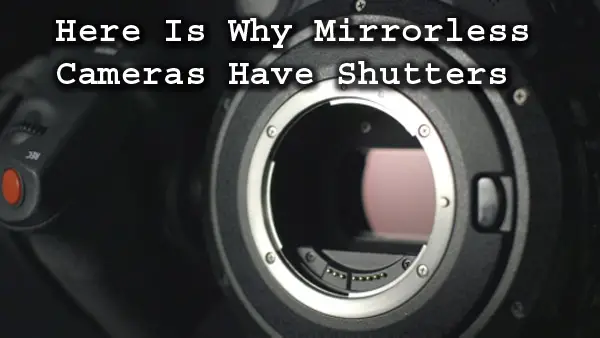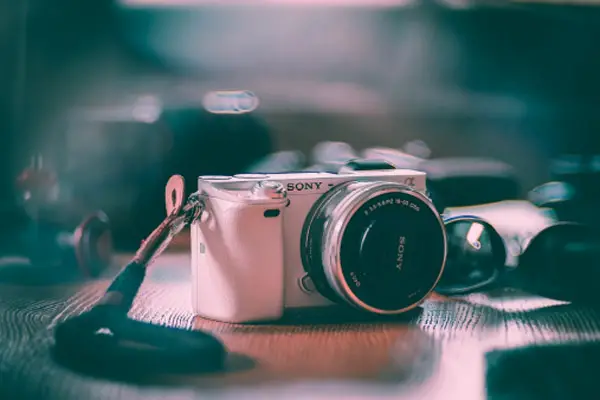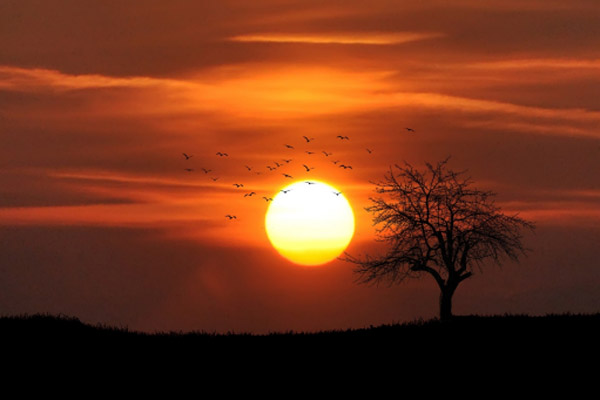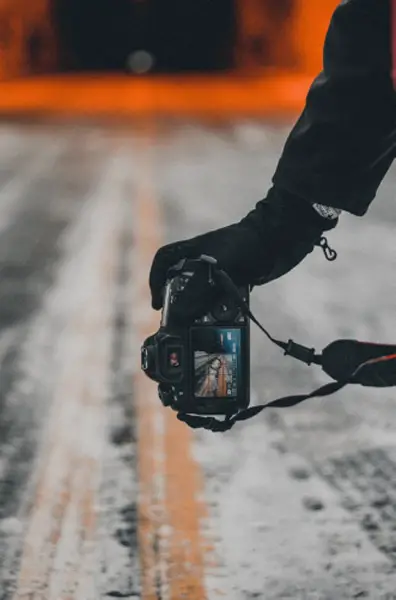Mirrorless cameras are becoming more and more popular not just with amateur photographers but with professional ones too. By doing away with the mirror system within the camera in favour of an electronic viewfinder and/or LCD screen the camera is able to be more compact, lighter and have smaller interchangeable lenses than its DSLR counterpart.

Using a sensor system similar to what you would find in your phone, it can be somewhat surprising that mirrorless cameras themselves still have shutters.
While your mobile phone will offer you the opportunity to still hear the well-known camera shutter sound via a sound recording, a mirrorless camera still gives you the opportunity for it to actually happen. While there are different types of shutters, the inclusion of a shutter on a mirrorless camera has helped persuade many professional photographers to make the switch from their bulky DSLRs.
Whether you’re a seasoned photographer or brand new, knowing how and why your camera works is the secret behind levelling up your photography game. As camera phones have demonstrated, mirrorless cameras could easily work without shutters but the fact they don’t should give you some clues as to why a mirrorless camera will (generally) outperform a camera phone. So, let’s uncover why mirrorless cameras have shutters.
How Do Shutters Work?
The shutter system in your camera is the thing that opens to let light through to expose the film or the digital sensor as is the case with digital cameras. The recording of the light either on the film or by the electronic sensor is what makes the image.
Most cameras have the ability to control how long the shutter is open for or how long the film/sensor is exposed for. This can either be done manually by the photographer or automatically by the camera.
How Do Mechanical Shutters Work?
There are two types of camera shutters that can be found on a mirrorless camera, mechanical shutters, and electronic shutters. Traditionally, camera shutters have always been mechanical, and it is this system from which the familiar photo taking noise comes from.
Mechanical DSLR Shutters
To understand why mirrorless cameras use mechanical shutters it is important to first understand how the shutter system in a DSLR works as this is where it was adapted from. The DSLR uses a mirrorbox which allows the photographer to see the exact image that is about the be captured on the electronic sensor. The electronic sense sits behind the mirrorbox and so it needs to be moved out of the way in order to capture the image.
Upon pressing the shutter button, the mirrorbox is flipped upwards out of the way of the sensor. This is also the reason why the view through the view finder goes black. Once the mirrorbox has flipped upwards it reveals the sensor which is covered by a shutter. The shutter will then move from top to bottom revealing the sensor and allowing the light to hit it.
After the allotted time, a second shutter will move from the top to the bottom of the sensor recovering it. The mirrorbox will then flip back down and the two shutter doors will reset ready to take another image.
Mechanical Mirrorless Shutters
As the name suggests, mirrorless cameras don’t have a mirrorbox or pentaprism to project the light into the viewfinder. Instead, a mirrorless camera uses an electronic viewfinder or and LCD screen to show you the image you are about to capture.

The sensor of a mirrorless camera is actually continuously exposed to light coming through the camera however, it is not until the shutter button is pressed that the image is “saved”. Up until that point the camera is recording the light that hits the sensor so that the photographer is able to see the image that they are about to capture through the electronic viewfinder or LCD screen.
When the shutter button is pressed, a shutter door rises from bottom to top and covers the sensor. Now the sensor will begin exposing (or saving/capturing the image) and the shutter doors moves back down. This allows the sensor to record and save the light before a second shutter door moves from top to bottom to recover the sensor thereby stopping the exposure (or saving). Finally, the doors will reset ready to capture another image.
Why Do Mirrorless Cameras Still Use Mechanical Shutters?
Back when all cameras used film, shutters were essential in ensuring you captured a great photo. Pre-developed film is light sensitive which means that if your camera constantly allowed light to hit the film in the same way that a mirrorless camera does to the electronic sensor then you would just end up with a bunch of over-exposed, white images.
So, the only way to ensure that you captured a correctly exposed image was to only allow light to hit the film for a set amount of time. While the development of the electronic sensor has meant that you can now turn a sensor on and off with or without a shutter door’s help, they still remain in some mirrorless cameras.
This is mainly to counter the image noise issue that you see in shutterless cameras such as camera phones and point-and-shoot cameras. In these cameras the sensor is constantly receiving light and so the camera has to constantly send power to the sensor tor record it. However, when the photographer hits the shutter button this sends a wave of even more power to the sensor to capture the image. This extra power works in the same way that extra (or increasing) ISO will do – it increases the noise.
Future advances in technology may mean that the mirrorless cameras that professionals use will eventually be shutterless as well but for now the quality of the images produced is not good enough to warrant not using a shutter.
Advantages to Using A Mechanical Shutter
- Sync better with flash – mechanical shutters tend to allow you to operate the flash at higher speeds than an electronic shutter
- The reduce noise that you in shutterless cameras
- Reduce Rolling Shutter distortions – Rolling shutters (a type of electronic shutter) can often result in lateral distortion of images especially when the camera is panned quickly, or a subject is on motion.
- They cope better than electronic shutter with flickering light sources
Disadvantages of Using A Mechanical Shutter
- Reduced Top Shutter Speed – The mechanical nature of these kinds of shutters means that the maximum speed is usually less than electronic shutters
- They have a life span – as mechanical shutters feature moving parts these are obviously prone to wear and tear and may stop working overtime. Most cameras that come with a mechanical shutter system will have a “shutter count” or number of times the shutter can be used before it might start to fail.
- Camera shake – The movement of the shutter doors and mirrorbox can cause minor camera shake although inbuilt image stabilisation can help reduce this.
- Response Time – Again due to the mechanical nature of the shutters there can be a minor delay between pressing the shutter button and the camera taking the photo.
This is what Robert Hall had to say about the shutter systems on mirrorless cameras:
How Do Electronic Shutters Work?
The development of the electronic sensor also brought with it the development of the electronic shutter. These types of shutters work in the same way as mechanical shutters in that they will expose the light for an allotted amount of time to capture an image.
However, unlike a mechanical shutter, the electronic shutter works by turning the sensor on and off again. There are two types of electronic shutters that are commonly used in mirrorless cameras, rolling shutters and global shutters.
What is a Rolling Electronic Shutter?
Rolling shutter cameras are more common in the more affordable amateur cameras and works by scanning a row of photosites on the sensor from left to right and then dropping down to the next row and scanning right to left. It snakes it way from the top left to the bottom right. The sensor is only turned on to capture the image during the time at which that particular part of the sensor is being scanned. Therefore, the time the exposure time is the time it takes to scan from the top left to the bottom right
While it can take as little as 1/16,000th second for each row to be scanned the total time is close to that of a slow mechanical shutter – between 1/10th second and 1/60th second. This is because it takes a moment for the camera to process the data from the sensor.
Using rolling shutters can be an issue if your subject is fast moving or if you are panning quickly in your shot. It can cause banding or distortions where a subject appears jelly-like because the image has changed between each row of the sensor being scanned.
What is a Global Electronic Shutter?
A global shutter, as the name suggests captures the entire image all at once in a similar way that a mechanical shutter camera does. Sometimes known as e-global shutters, they allow light to hit and be recorded across the entire sensor simultaneously in either a “hard” or “soft” exposure.
A hard shutter exposure works like turning a light switch on and off. The sensor goes from not recording to recording and back again in an instant. A soft shutter exposure, on the other hand, works more like a sunrise and sunset with the sensor being exposed and obstructed more gradually.

Global shutters also require the camera to have a sensor with a very high read speed so that it can process all the data that is being captured. Obviously, this makes using global shutters in cameras with larger sensors more difficult and why they are most common in cine cameras. However, they are becoming more common in mirrorless cameras especially in cameras with M4/3 sensors.
Advantages to Using Electronic Shutters
- They are silent – without the moving parts of a mechanical shutter the camera is silent which is great for wildlife photographers and other situations when you need to not make any noise.
- Faster shutter speeds – electronic shutters eliminate the mechanical shutter delay meaning that a shutter speed of 1/32000th second is not that unusual.
- Higher continuous shooting rates – as the camera doesn’t need to wait for the mirror and shutters to physically reset it can be ready to take the next photo quicker.
- No more blackout – as these cameras use an electronic viewfinder you can continue to see through the viewfinder through the shot which is great for long exposures, panning and continuous shooting.
Disadvantages of Using Electronic Shutters
- Potential for Banding and jelly-like distortion in rolling shutters – this is especially prevalent in fast moving subjects and during panning.
- Flickering light banding – electronic shutters don’t always cope with flickering light sources and often banding can be seen which is difficult to remove.
- Slow flash sync speeds – while you can still sync flashes with cameras using electronic shutters the top sync speed is generally much lower.
- Obstructed use – in some cameras, using the electronic shutter can stop you from using some features of the camera.
What Is an Electronic Front-curtain Shutter?
The electronic front-curtain shutter (EFCS) is becoming a common feature in DSLRs and especially mirrorless cameras. It has been developed as a kind of hybrid of mechanical and electronic shutter action allowing the photographer to overcome particular shutter issues, although it doesn’t eliminate them all.
One of the most common issues with mechanical shutters is shutter shock, or the blurring of an image due to the shake that the first shutter (front-curtain) causes when moving. As the second shutter, or rear curtain, moves at the end of the exposure it doesn’t add to the camera shake. Therefore, if you can find a way to stop the front curtain camera shake you get rid of shutter shock.

This is how EFCS was born. When EFCS is being used the exposure is started electronically and finished using a mechanical shutter. This makes complete sense especially when considering mirrorless cameras and their lack of mirrors.
As I explained earlier, without the mirrorbox, the light is constantly hitting the sensor of a mirrorless camera so it seems a little redundant to have to close a shutter to then have to immediately re-open it again to expose for the image. If nothing else, it wastes time.
However, while EFCS may seem like the shutter saviour it does have a few downsides. For starters because it has to read the whole sensor at the start of the exposure and this takes time, its sometimes not great when you’re shooting fast moving subjects. For this reason, cameras that use EFCS often have limited maximum shutter speed. So, if photographing competitive cyclists or cheaters is your thing a mechanical shutter camera might be a better option. Other downsides such as flickering, and banding are due to the electronic nature of the shutter whereas because of the mechanical rear curtain it will be louder than an electronic shutter.
Which Kind of Shutter Should I Use with My Mirrorless Camera?
A lot of cameras nowadays enable you to decide whether to use a mechanical, electronic or hybrid shutter for capturing your images. Some cameras will even let you leave it up to the cameras microprocessor if you put it into automatic mode. However, if you’re looking to get the most out of your photography having a basic understanding of which types of shutter lend themselves best to which type of photography isn’t going to do you any harm.
Landscape Photography
A fully electronic shutter setup is a great choice for shooting landscapes. However, if you find that there is quite a lot of artificial light or fast-moving subjects such as wildlife it may be better to switch to a mechanical shutter (or EFCS). As electronic shutters can sometimes prevent certain features such as long exposure noise reduction from being used it may be better to switch to a mechanical shutter in low light conditions
Portrait Photography
Portraiture lends itself to mechanical shutter setups by default. This is especially true if you are using a flash. However, if you are shooting outside and risk overexposure it may be better to switch to an electronic shutter if the shutter speed allows.
Sports, Wildlife and Marco
To avoid rolling shutter issues and eliminate banding opt for mechanical shutter for these kinds of photography.
Documentary Photography
This type of photography works best with electronic shutters as it allows you to shoot silently. However, switching to mechanical shutters may work best if you are indoors.
Cityscape & Architecture
If there is artificial light in your shot, use mechanical shutters.
As technology continues to progress the future may see the need to stop using mechanical shutters in favour of fully electronic. However, at least for now, the advantages of having at least a hybrid system in terms of the quality of the images produced far outweigh not having them.
Learn more about mirrorless cameras and find the right mirrorless camera for you here.








